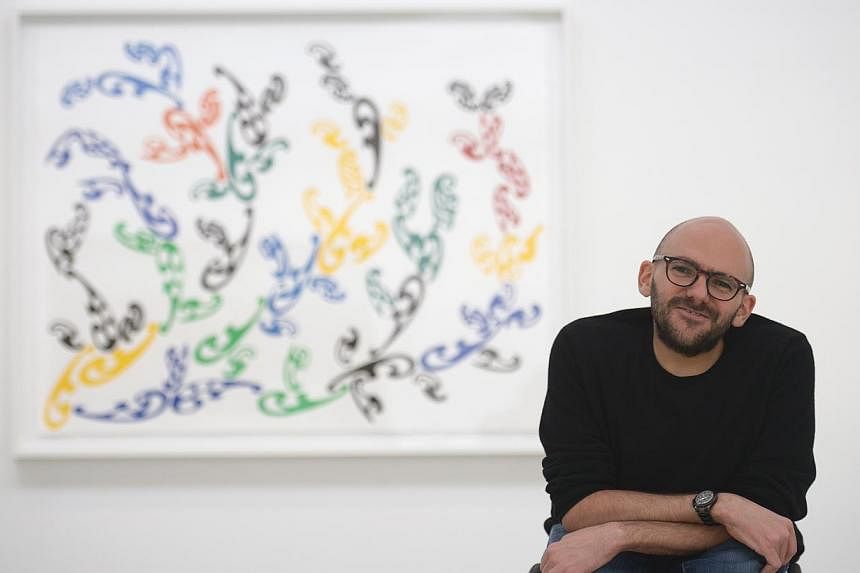When asked to smile just a little for the photo shoot ahead of this interview, British artist Ryan Gander jokes: "I am a conceptual artist, I do not know how to smile."
Soon, he is complimenting the photographer on his shoes.
His attention to shoes demonstrates his interest in details that escape the attention of others. In a 45-minute interview at print institute STPI, where a solo exhibition of his works is running, he is by turns serious and funny.
"As an artist, it is my job to be interested in everything. I read everything. From literature to kitchen catalogues to golf magazines to porn," he tells Life!.
The inspiration for his work, too, comes from "everything".
"Art is about provoking the mind," he says and the title of his show Portrait Of A Blind Artist Obscured By Flowers is provocative enough.
Hailed by critics for his "extraordinary diversity", the multidisciplinary artist's credits include a solo exhibition at New York's Guggenheim Museum and participation in the prestigious Documenta 13 group show in 2012 in Kassel, Germany.
The charming Gander, 38, knows how to have fun with his art - at the 2011 Venice Biennale, he had presented a sculpture representing himself falling from a wheelchair. He has been wheelchair-bound since childhood because of illness.
The image that greets visitors when they enter the STPI gallery is one of the artist himself obscured by flowers. It references German great Gerhard Richter's portrait of his daughter Betty, which shows only the back of her body.
Gander says: "The idea that she does not show her face, the fact that she is obscured, means she is absolutely beautiful."
At a time when images are being uploaded instantaneously on social media platforms, the artist is intrigued by the idea of what is obscured and how that makes people imagine or even look at an image.
His solo at the institute explores many such ideas. There are 32 artworks in the gallery, with prices ranging from $200 for unframed pieces to $140,000 for the large works.
While most artists tend to have a distinctive voice and some sort of uniformity in the works they create during their print residency here, his solo is a nod to his diverse art practice.
There are references to famous visuals such as Japanese artist Hokusai's Great Wave, Matisse's cut-outs and Richter's photo paintings, as well as graphic design elements complete with catchy artwork titles.
One such piece was created when he went to the art supplies shop Art Friend at Bras Basah Complex and found an assortment of French curve rulers.
He explains: "I enjoy going to such shops, even DIY shops, to see what I can find there. I find anything and everything I find can be used as a tool in the process of art-making.
"We did a few experiments with the curve rulers and the results were quite creative. As an artist, I really enjoy being tested and this was turning out to be a good test."
The curve rulers ended up being used as relief printing plates for a series of works called Seriously Retinal/Serious Poke, which are rendered in black- and-white and full colour.
He likens STPI's facilities to "Jedi printing", which allowed him to try out many things he did not think he could. He revisited several aspects of art history, particularly the works of artists and printmakers from Matisse to Richter.
Inspired by his surroundings, he says he looked at what the greats had created and indulged in "imagineering" - something that blends imagining and engineering to find fresh ways of interpreting what already exists in the realm of printmaking, be it with a simple ruler or through the imagining of a famous artist's painting.
He pulls out his smart phone, taps on the notes to point to the many "starting points" for his residency, including sketches of his five-year-old daughter. The idea behind all these influences was also to look at ways of giving life to what already exists.
Gander divides his time between London and Suffolk and has two young daughters. His wife Rebecca is a gallerist. He studied interactive art at the Manchester Metropolitan University and has been awarded numerous prestigious art prizes including the Zurich Art Prize (2009) and the 2003 Dutch Prix de Rome for sculpture (2003).
His often cryptic creations - from chess sets made from spare car parts to trainers designed by him - have made him among the world's most exciting young talents.
Gander says, as a conceptual artist, he does not rule out any possibility: "I have to be interested in all you do." He has even written television scripts and spent a year on Instagram, only to understand "how social media works".
He shut down his Instagram account after a year, saying "being on social media always makes you feel like you are missing out on something".
Ask him if he had imagined a life without art and he responds: "If I wasn't an artist, I'd be reading novels by Paul Auster."
The American author is known for his genredefying writing blending elements of absurdism, existentialism and crime fiction.
That Gander should pick him comes as absolutely no surprise.

